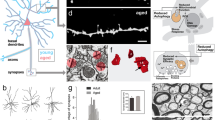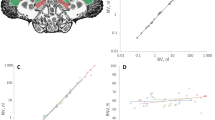Summary
Behavioral, light and electron microscopic studies of young and oldDrosophila melanogaster are presented. Negative geotaxis and mating studies were used as indices of behavior; these began to decline at ages 28–35 days and very low values were obtained at 70 to 85 days. With the light microscope the brains of the old flies demonstrated shrinkage of the cortex, loss of basophilia in the cytoplasm of the giant neurons (neurosecretory cells), and vacuolation in the neuropil. Electron microscopy of the brains of aged flies revealed a marked loss of free ribosomes and granular endoplasmic reticulum and increased cytoplasmic lipid and autophagic vacuoles in neurosecretory cells. There was also a general decrease in the amount of neuronal cytoplasm. Vacuoles and pale processes, sometimes identified as swollen cell processes, were frequently seen in the deep cortex and neuropil. A heterogeneous population of dense bodies was found in the neuropil. Morphologically the bodies resemble lipoprotein complexes and are consistent with age pigment, but further characterization awaits biochemical studies.
Similar content being viewed by others
References
Baumann, P. A.: Untersuchungen zum Proteinstoffwechsel bei alternden Adultmännchen, Larven des Wildtyps und der Letalmutanten (ltr undlme) vonDrosophila melanogaster. Z. vergl. Physiol.64, 212–242 (1969).
— Chen, P. S.: Alterung und Proteinsynthese beiDrosophila melanogaster. Rev. suisse Zool.75, 1051–1055 (1969).
Bender, A. D., Kormendy, C. G., Powell, R.: Pharmacological control of aging. Exp. Geront.5, 97–129 (1970).
Boeckh, J., Sandri, C., Akert, K.: Sensorische Eingänge und synaptische Verbindungen im Zentralnervensystem von Insekten. Z. Zellforsch.103, 429–446 (1970).
Burch, G. E., Sohal, R., Fairbanks, L. D.: Ultrastructural changes inDrosophila heart with age. Arch. Path.89, 128–136 (1970).
Frontali, N., Norberg, K.-A.: Catecholamine containing neurons in the cockroach brain. Acta physiol. scand.66, 243–244 (1966).
Hsiao, C., Fraenkel, G.: Neurosecretory cells in the central nervous system of the adult blowflyPhormia regina meigen (Diptera: Calliphoridae). J. Morph.119, 21–36 (1966).
Karnovsky, M. J.: Simple methods for “staining with lead” at high pH in electron microscopy. J. biophys. biochem. Cytol.11, 729–732 (1961).
Lamparter, H. E., Akert, K., Sandri, C.: Wallersche Degeneration im Zentralnervensystem der Ameise. Elektronenmikroskopische Untersuchungen am Prothorakalganglion von Formica lugubris. Zett. Schweiz. Arch. Neurol. Neurochir. Psychiat.100, 337–354 (1967).
Miller, A.: The internal anatomy and histology of the imago ofDrosophila melanogaster. In: Biology of Drosophila. Edited by M. Demerec, pp. 420–534. New York-London: Hafner Publishing C. 1965.
Miquel, J.: Aging of maleDrosophila melanogaster: histological, histochemical and ultrastructural observations. In: Advances in gerontological research, pp. 39–71. Edited by B. L. Strehler, Vol. III. New York: Academic Press 1971.
— Calvo, W.: Un nuevo método sencillo y rapido para la tinción histopatólogica. Arch. esp. Morf.14, 125–129 (1958).
—— Rubinstein, L. J.: A simple and rapid stain for the biopsy diagnosis of brain tumors. J. Neuropath. exp. Neurol.27, 517–523 (1968).
Osborne, M. P.: Personal communication as quoted in: Philpott, D. E., Weibel, J., Atlan, H., Miquel, J.: Viruslike particles in the fat body, oenocytes, and central nervous tissue ofDrosophila melanogaster imagoes. J. Invertebr. Path.14, 31–38 (1969).
Panov, A. A., Kind, T. V.: The neurosecretory cell system in the lepidopteran brain (Lepidoptera: Insecta). Doklady Akad. Nauk SSSR.153, 1186–1189 (1963).
Porta, E. A., Hartroft, W. S.: Lipid pigments in relation to aging and dietary factors (lipofuscins).In: Pigments in pathology. Edited by M. Wolman, pp. 191–235. New York-London: Academic Press 1969.
Power, M. E.: The brain ofDrosophila melanogaster. J. Morph.72, 517–559 (1943).
Reynolds, E. S.: The use of lead citrate at high pH as an electron-opaque stain in electron microscopy. J. Cell Biol.17, 208–212 (1963).
Rudzinska, M. A.: The use of protozoan for studies on aging. I. Differences between young and old organisms ofTokophyra infusionum as revealed by light and electron microscopy. J. Geront.16, 213–224 (1961).
Samis, H. V., Erk, F. C., Baird, M. B.: Senescence inDrosophila. I. Sex differences in nucleic acid, protein and glycogen levels as a function of age. Exp. Geront.6, 9–18 (1971).
Scharrer, B.: Endocrines in invertebrates. Physiol. Rev.21, 383–409 (1941).
Smith, D. S.: The organization of the insect neuropile. In: Invertebrate nervous systems. Edited by C. A. G. Wiersma, pp. 79–85. Chicago: The University of Chicago Press 1967.
Strehler, B. L.: On the histochemistry and ultrastructure of age pigment. In: Advances in gerontological research. Edited by B. L. Strehler, Vol. I, pp. 343–384. New York-London: Academic Press 1964.
Takahashi, A., Philpott, D. E., Miquel, J.: Electron microscope studies on agingDrosophila melanogaster. I. Dense bodies. J. Geront.25, 210–217 (1970a).
———: Electron microscope studies on agingDrosophila melanogaster. III. Flight muscle. J. Geront.25, 222–228 (1970b).
Toth, S. E.: The origin of lipofuscin age pigments. Exp. Geront.3, 19–30 (1968).
Westrum, L. E.: A combination staining technique for electron microscopy. I. Nervous tissue. J. Microscopie4, 275–278 (1965).
Author information
Authors and Affiliations
Rights and permissions
About this article
Cite this article
Herman, M.M., Miquel, J. & Johnson, M. Insect brain as a model for the study of aging. Acta Neuropathol 19, 167–183 (1971). https://doi.org/10.1007/BF00684595
Received:
Issue Date:
DOI: https://doi.org/10.1007/BF00684595




